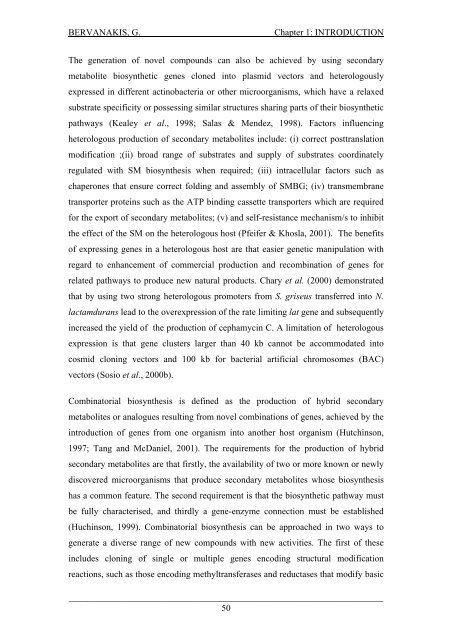Detection and Expression of Biosynthetic Genes in Actinobacteria ...
Detection and Expression of Biosynthetic Genes in Actinobacteria ...
Detection and Expression of Biosynthetic Genes in Actinobacteria ...
Create successful ePaper yourself
Turn your PDF publications into a flip-book with our unique Google optimized e-Paper software.
BERVANAKIS, G.Chapter 1: INTRODUCTIONThe generation <strong>of</strong> novel compounds can also be achieved by us<strong>in</strong>g secondarymetabolite biosynthetic genes cloned <strong>in</strong>to plasmid vectors <strong>and</strong> heterologouslyexpressed <strong>in</strong> different act<strong>in</strong>obacteria or other microorganisms, which have a relaxedsubstrate specificity or possess<strong>in</strong>g similar structures shar<strong>in</strong>g parts <strong>of</strong> their biosyntheticpathways (Kealey et al., 1998; Salas & Mendez, 1998). Factors <strong>in</strong>fluenc<strong>in</strong>gheterologous production <strong>of</strong> secondary metabolites <strong>in</strong>clude: (i) correct posttranslationmodification ;(ii) broad range <strong>of</strong> substrates <strong>and</strong> supply <strong>of</strong> substrates coord<strong>in</strong>atelyregulated with SM biosynthesis when required; (iii) <strong>in</strong>tracellular factors such aschaperones that ensure correct fold<strong>in</strong>g <strong>and</strong> assembly <strong>of</strong> SMBG; (iv) transmembranetransporter prote<strong>in</strong>s such as the ATP b<strong>in</strong>d<strong>in</strong>g cassette transporters which are requiredfor the export <strong>of</strong> secondary metabolites; (v) <strong>and</strong> self-resistance mechanism/s to <strong>in</strong>hibitthe effect <strong>of</strong> the SM on the heterologous host (Pfeifer & Khosla, 2001). The benefits<strong>of</strong> express<strong>in</strong>g genes <strong>in</strong> a heterologous host are that easier genetic manipulation withregard to enhancement <strong>of</strong> commercial production <strong>and</strong> recomb<strong>in</strong>ation <strong>of</strong> genes forrelated pathways to produce new natural products. Chary et al. (2000) demonstratedthat by us<strong>in</strong>g two strong heterologous promoters from S. griseus transferred <strong>in</strong>to N.lactamdurans lead to the overexpression <strong>of</strong> the rate limit<strong>in</strong>g lat gene <strong>and</strong> subsequently<strong>in</strong>creased the yield <strong>of</strong> the production <strong>of</strong> cephamyc<strong>in</strong> C. A limitation <strong>of</strong> heterologousexpression is that gene clusters larger than 40 kb cannot be accommodated <strong>in</strong>tocosmid clon<strong>in</strong>g vectors <strong>and</strong> 100 kb for bacterial artificial chromosomes (BAC)vectors (Sosio et al., 2000b).Comb<strong>in</strong>atorial biosynthesis is def<strong>in</strong>ed as the production <strong>of</strong> hybrid secondarymetabolites or analogues result<strong>in</strong>g from novel comb<strong>in</strong>ations <strong>of</strong> genes, achieved by the<strong>in</strong>troduction <strong>of</strong> genes from one organism <strong>in</strong>to another host organism (Hutch<strong>in</strong>son,1997; Tang <strong>and</strong> McDaniel, 2001). The requirements for the production <strong>of</strong> hybridsecondary metabolites are that firstly, the availability <strong>of</strong> two or more known or newlydiscovered microorganisms that produce secondary metabolites whose biosynthesishas a common feature. The second requirement is that the biosynthetic pathway mustbe fully characterised, <strong>and</strong> thirdly a gene-enzyme connection must be established(Huch<strong>in</strong>son, 1999). Comb<strong>in</strong>atorial biosynthesis can be approached <strong>in</strong> two ways togenerate a diverse range <strong>of</strong> new compounds with new activities. The first <strong>of</strong> these<strong>in</strong>cludes clon<strong>in</strong>g <strong>of</strong> s<strong>in</strong>gle or multiple genes encod<strong>in</strong>g structural modificationreactions, such as those encod<strong>in</strong>g methyltransferases <strong>and</strong> reductases that modify basic_____________________________________________________________________50















